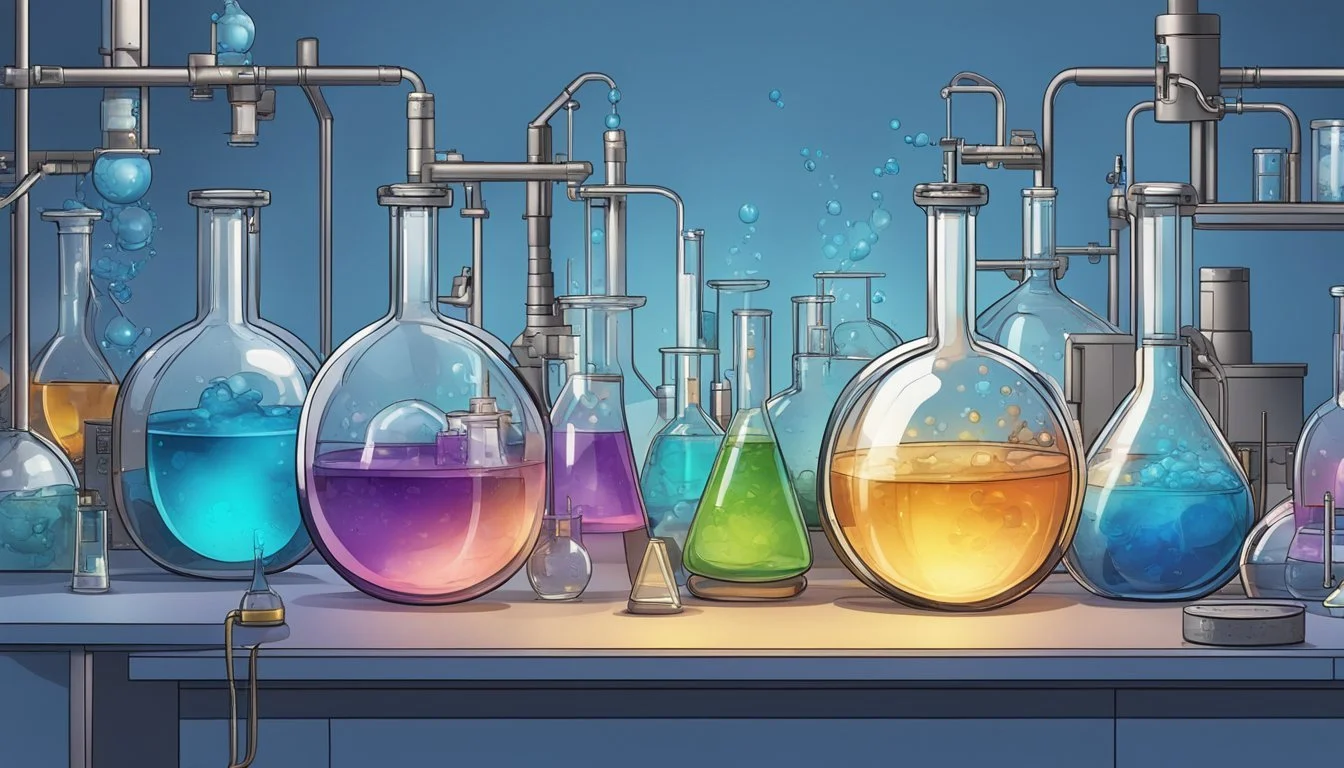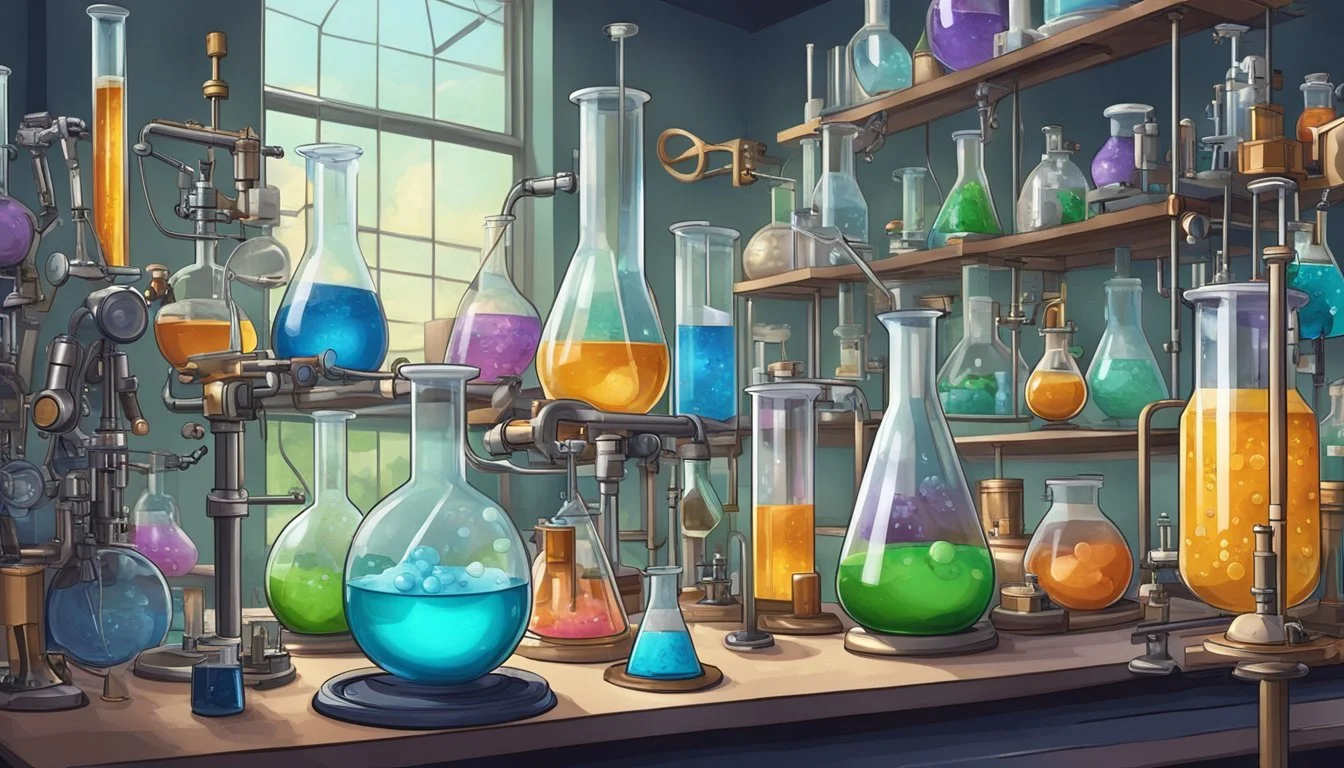The Significance of Walt's Chemistry Knowledge: Science as Power
Breaking Bad's Deadly Formula
Walter White's chemistry expertise forms the cornerstone of his transformation in "Breaking Bad." As a high school teacher with a Ph.D. and contributions to Nobel Prize-winning research, Walt possesses an exceptional understanding of chemical processes. His scientific knowledge becomes a powerful tool, enabling him to produce high-quality methamphetamine and navigate the dangerous world of drug manufacturing.
This mastery of chemistry sets Walt apart from other characters in the series. It allows him to create a distinctive "blue meth" that becomes his trademark in the criminal underworld. As Walt delves deeper into the drug trade, his scientific skills become increasingly crucial for his survival and success.
Chemistry serves as both a literal and metaphorical force in Walt's journey. The show uses chemical reactions to symbolize Walt's changing personality and moral decay. His scientific prowess fuels his rise to power, transforming him from a mild-mannered teacher into the formidable drug kingpin known as Heisenberg. Walt's chemistry knowledge becomes a double-edged sword, granting him unprecedented control while simultaneously leading to his downfall.
Walter White's Persona and the Birth of Heisenberg
Walter White's transformation from a meek chemistry teacher to the infamous drug lord Heisenberg marks a profound shift in his identity. This change stems from his cancer diagnosis and leads to a complete reinvention of his persona.
Cancer Diagnosis and Transformation
Walter White's terminal cancer diagnosis serves as the catalyst for his metamorphosis. Faced with his mortality and financial concerns, Walt makes the fateful decision to enter the dangerous world of methamphetamine production. This choice ignites a series of events that reshape his character.
The diagnosis pushes Walt to embrace previously dormant aspects of his personality. He begins to exhibit increased assertiveness and a willingness to take risks. His scientific expertise, once confined to the classroom, becomes a powerful tool in his new criminal enterprise.
Identity Shift from Chemistry Teacher to Drug Lord
Walt's adoption of the Heisenberg persona represents a complete departure from his former self. He sheds his timid demeanor and adopts a confident, often ruthless alter ego. This new identity is visually reinforced through a stark change in appearance - shaved head, dark clothing, and the iconic pork pie hat.
As Heisenberg, Walt leverages his chemistry knowledge to produce high-quality methamphetamine. This fusion of scientific expertise and criminal ambition quickly establishes him as a formidable figure in the drug trade. The Heisenberg persona allows Walt to compartmentalize his actions, separating his criminal activities from his family life.
The transformation impacts Walt's relationships and decision-making. He becomes increasingly manipulative and willing to resort to violence to protect his interests. This shift blurs the lines between Walter White and Heisenberg, raising questions about his true nature.
The Role of Chemistry in Walter White's Life
Chemistry profoundly shaped Walter White's trajectory, transforming him from a high school teacher to a drug kingpin. His expertise became both a lifeline and a weapon as he navigated the criminal underworld.
Chemistry as a Tool for Financial Security
Walter's chemistry knowledge provided a path to financial stability when faced with a terminal cancer diagnosis. He leveraged his expertise to produce high-purity methamphetamine, creating a product far superior to competitors. This "blue meth" became his trademark, commanding premium prices in the drug market.
Walter applied principles of organic synthesis and chemical purification to maximize yields and potency. His background allowed him to source precursor chemicals and set up clandestine laboratories efficiently.
The financial rewards were substantial. Walter's meth operation generated millions of dollars, far exceeding what he could have earned as a teacher.
Chemical Knowledge as a Source of Power
Walter's scientific acumen gave him a significant edge in the criminal world. He used chemistry not just for drug production, but as a tactical advantage against rivals and law enforcement.
He weaponized chemical reactions, like using fulminated mercury as an explosive and thermite to break into secure locations. Walter neutralized bodies with hydrofluoric acid and created poisonous phosphine gas as a defensive measure.
His alias "Heisenberg" referenced the Uncertainty Principle in quantum mechanics, reflecting his elusive nature. This scientific persona intimidated competitors unfamiliar with his methods.
Walter's expertise allowed him to solve problems creatively, cementing his position as a formidable player in the drug trade. Chemistry became the foundation of his criminal empire and ultimate source of power.
Methamphetamine Production: Science, Skill, and Secrecy
Walter White's chemistry expertise enables high-purity methamphetamine synthesis through precise techniques and equipment. The clandestine nature of production requires careful planning and discretion.
Recipe and Craft of Meth Cook
The methamphetamine synthesis process involves several key steps and chemicals. Pseudoephedrine or methylamine serve as precursors. Reductive amination converts these to methamphetamine.
Precise temperature control and timing are critical. Even small errors can ruin a batch or create dangerous byproducts.
Walt's background allows him to achieve 99.1% purity - far exceeding typical street quality. This gives his product a signature blue color and potency.
Proper ventilation and safety gear protect against toxic fumes. However, these are often neglected in makeshift labs.
Operation and Security of Meth Lab
Meth labs require specialized glassware, heating elements, and chemical supplies. Mobile setups in RVs offer flexibility but limit production capacity.
Large-scale operations use industrial equipment for higher yields. Gus Fring's superlab exemplifies this with state-of-the-art facilities.
Secrecy is paramount. Labs are hidden in remote locations or disguised as legitimate businesses. Chemical purchases are carefully tracked by law enforcement.
Proper disposal of waste and equipment is essential to avoid detection. Strong odors from production can alert neighbors or authorities.
Lab security involves limiting access and screening workers. Jesse and Walt take precautions like wearing hazmat suits and using code names.
Pivotal Relationships and Character Development
Walter White's chemistry expertise shaped his interactions and alliances in the criminal underworld. His scientific knowledge became a tool for manipulation and a source of respect among both allies and adversaries.
Dynamic Between Walter White and Jesse Pinkman
Walter and Jesse's partnership was founded on their shared chemistry background. Walt's superior knowledge initially gave him power over Jesse, acting as a mentor figure. This dynamic shifted as Jesse gained experience and confidence in their illegal operations.
Walt often leveraged his scientific skills to solve problems, impressing Jesse and reinforcing his authority. Their relationship was marked by periods of collaboration and conflict, with chemistry at the core of their business and personal interactions.
As the series progressed, Jesse's growing competence in meth production challenged Walt's position as the indispensable chemist. This shift in power dynamics fueled tensions between them.
Alliances and Conflicts within the Drug Trade
Walt's chemistry prowess made him a valuable asset in the drug trade, attracting attention from major players like Gustavo Fring. His ability to produce high-quality methamphetamine set him apart from other cooks.
Fring recognized Walt's scientific talents, leading to a complex business relationship. Walt's expertise became both a bargaining chip and a source of conflict in their dealings.
In negotiations and confrontations with rival organizations, Walt often relied on his chemistry knowledge to gain an edge. He used scientific principles to create innovative solutions to problems, from drug production to eliminating enemies.
Walt's scientific background also influenced how other characters perceived and interacted with him. His calculated approach to the drug business, rooted in his chemistry expertise, earned him respect and fear in equal measure.
Breaking Bad: Craft and Symbolism
Breaking Bad's masterful use of chemistry as both plot device and metaphor elevates the show's storytelling. The series weaves scientific concepts into its narrative fabric, creating layers of meaning that enrich the viewing experience.
The Rich Metaphors and Symbolic Use of Chemistry
Chemistry serves as a powerful metaphor throughout Breaking Bad. Walter White's expertise in the field becomes a tool for transformation, both of substances and of his own identity. The process of cooking meth mirrors Walt's metamorphosis from teacher to criminal mastermind.
The purity of Walt's product symbolizes his perfectionism and growing power in the drug world. His blue meth becomes a brand, representing his influence and the corruption of his scientific knowledge.
Chemical reactions also reflect the volatile relationships between characters. Like unstable compounds, alliances form and break apart, often with explosive results.
Narrative Elements and Vince Gilligan's Vision
Vince Gilligan crafted a narrative that balances scientific accuracy with dramatic tension. The show's attention to detail in portraying chemical processes lends credibility to Walt's expertise.
Gilligan uses Walt's chemistry background to drive key plot points. From using fulminated mercury as a weapon to dissolving bodies in hydrofluoric acid, science becomes integral to the story's progression.
The periodic table motif in the show's opening credits hints at the elemental nature of the characters' transformations. Each episode title is framed as a chemical formula, further embedding the scientific theme.
Influence of 'Leaves of Grass' by Walt Whitman
Walt Whitman's "Leaves of Grass" plays a crucial symbolic role in Breaking Bad. The book serves as a link between Walter White and his namesake, highlighting themes of self-discovery and transformation.
Gale Boetticher's gift of the book to Walt becomes a pivotal plot point, ultimately leading to Walt's downfall. The inscription inside connects Walt to his criminal alter ego, Heisenberg.
Whitman's poetry, celebrating the self and the natural world, contrasts with Walt's descent into moral corruption. This juxtaposition underscores the show's exploration of identity and the consequences of one's choices.
Morality and Legacy in the Life of a Drug Kingpin
Walter White's journey from high school chemistry teacher to drug kingpin raises profound questions about morality and legacy. His actions had far-reaching consequences for his family and society.
The Ethical Quandaries and Moral Decay of Walter White
Walter White's initial justification for entering the drug trade was securing his family's financial future after his cancer diagnosis. This seemingly noble motivation quickly gave way to a descent into moral corruption.
As "Heisenberg," Walt embraced increasingly unethical actions. He rationalized violence, manipulation, and the destruction of lives through his meth production.
Walt's expertise in chemistry became a tool for amassing power and wealth in the criminal underworld. His scientific knowledge, once used to educate, transformed into a means of domination and control.
The blurring of Walt's dual identities - family man and drug lord - highlighted his moral decay. He sacrificed his principles and relationships in pursuit of power and recognition.
Heisenberg's Lasting Impact on Family and Legacy
Walt's actions as Heisenberg had devastating effects on his family. His wife Skyler became complicit in his crimes, while his son Walt Jr. grappled with his father's true nature.
The drug empire Walt built left a trail of destruction. Countless lives were ruined by the high-quality methamphetamine he produced and distributed.
Walt's legacy is complex and tainted. While he achieved notoriety and financial success, it came at the cost of his moral integrity and familial bonds.
The name "Heisenberg" became synonymous with fear and power in the criminal world. This infamous reputation stood in stark contrast to Walt's original goal of providing for his family.
The Broader 'Breaking Bad' Universe
The 'Breaking Bad' universe extends beyond Walter White's story, exploring other characters and storylines set in Albuquerque's criminal underworld. This expansion provides deeper insights into the drug trade and its far-reaching impacts.
Expansion in 'Better Call Saul'
'Better Call Saul' serves as a prequel to 'Breaking Bad', focusing on the transformation of Jimmy McGill into Saul Goodman. The series delves into Albuquerque's legal and criminal landscapes before Walter White's entrance.
Jimmy's journey parallels Walt's in some ways, showcasing a descent into moral ambiguity. The show explores the intricacies of the drug trade from a legal perspective, revealing how criminal enterprises operate within and around the law.
'Better Call Saul' introduces new characters while expanding on familiar ones. It provides backstories for Mike Ehrmantraut and Gus Fring, offering insights into the established criminal networks Walt later encounters.
The series maintains the focus on character development and moral dilemmas that made 'Breaking Bad' compelling. It explores themes of identity, ambition, and the blurred lines between right and wrong in the criminal world.






